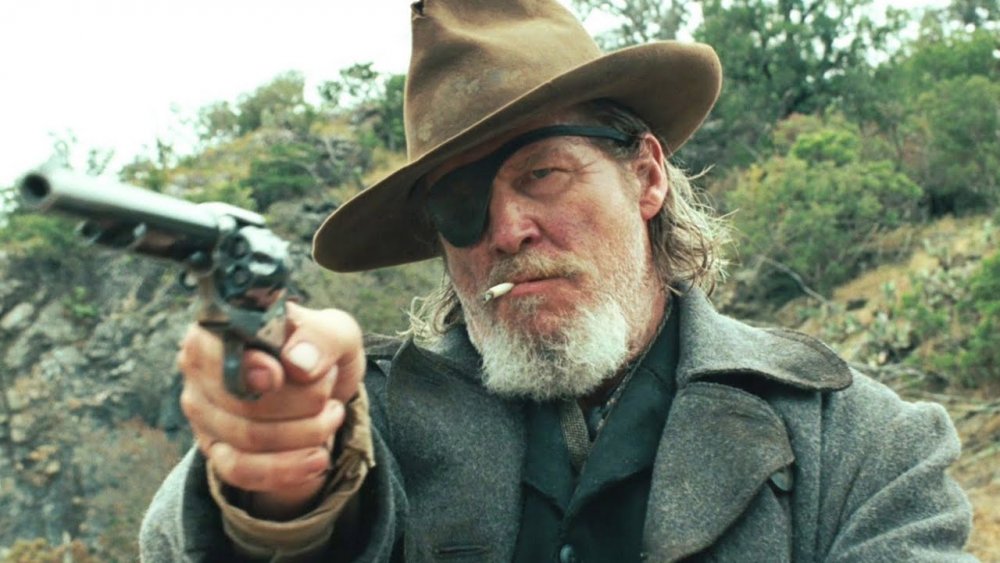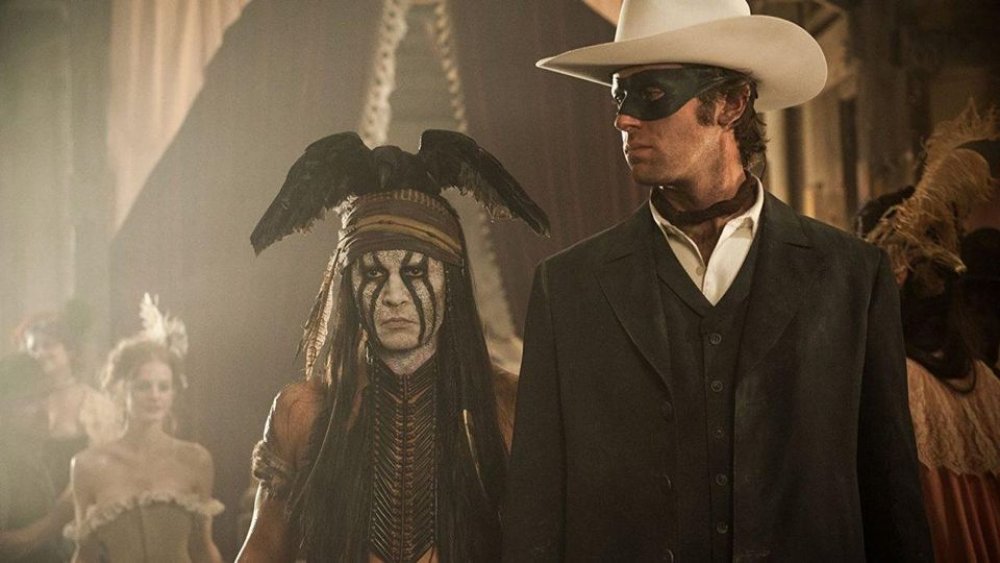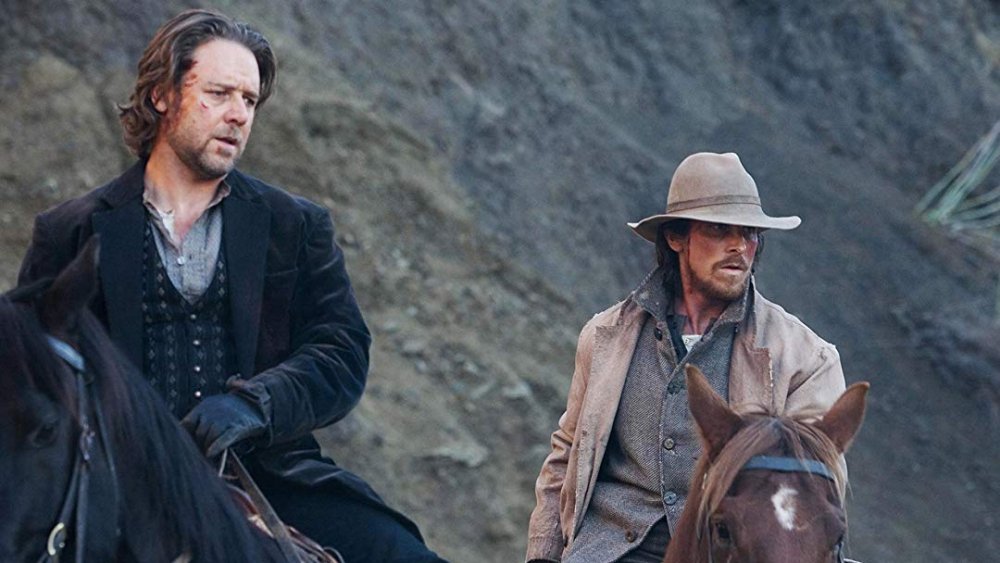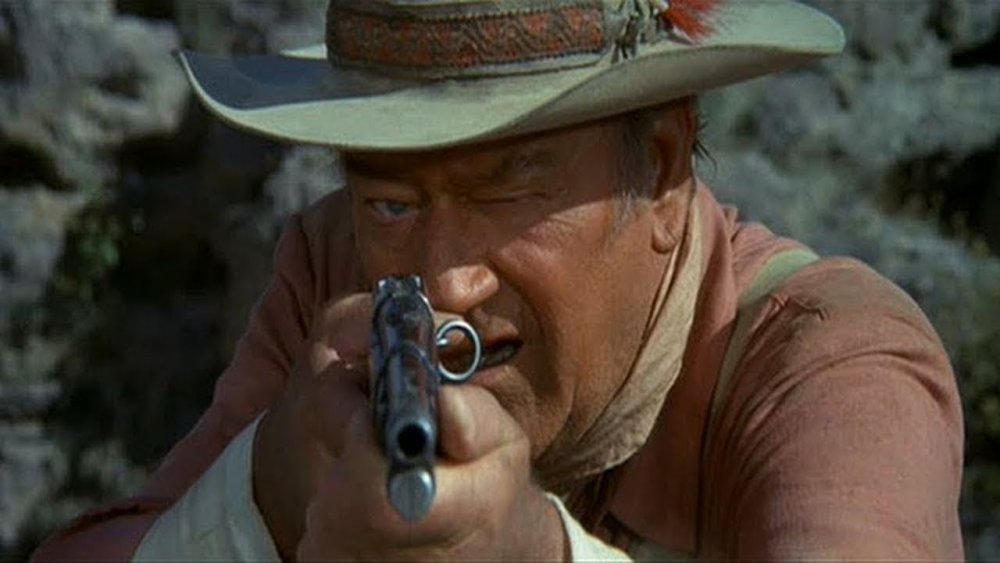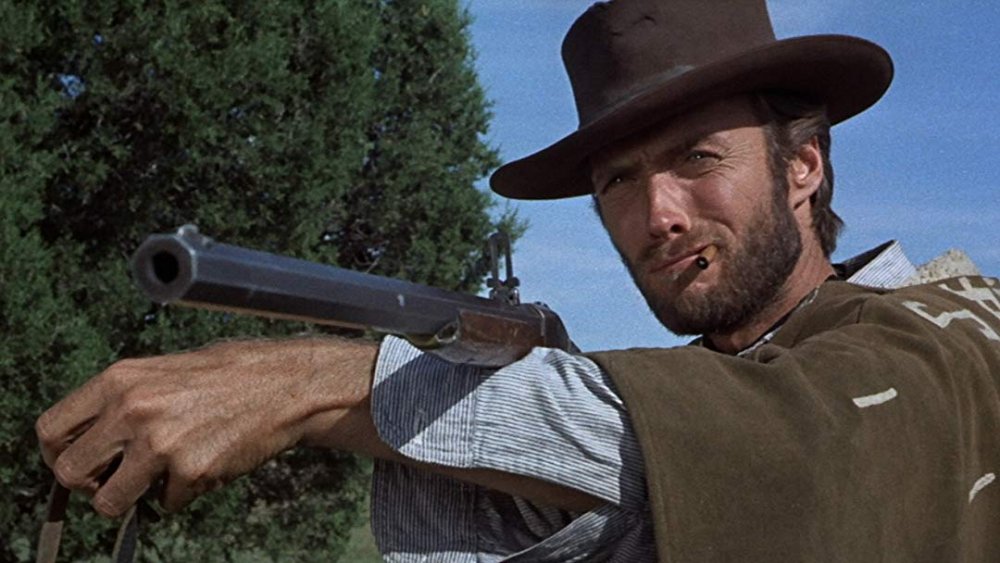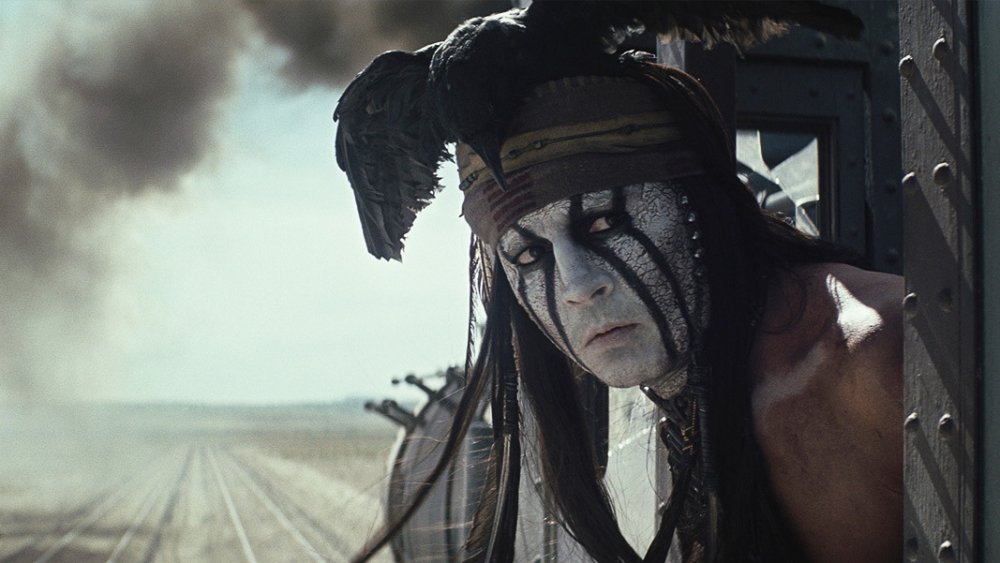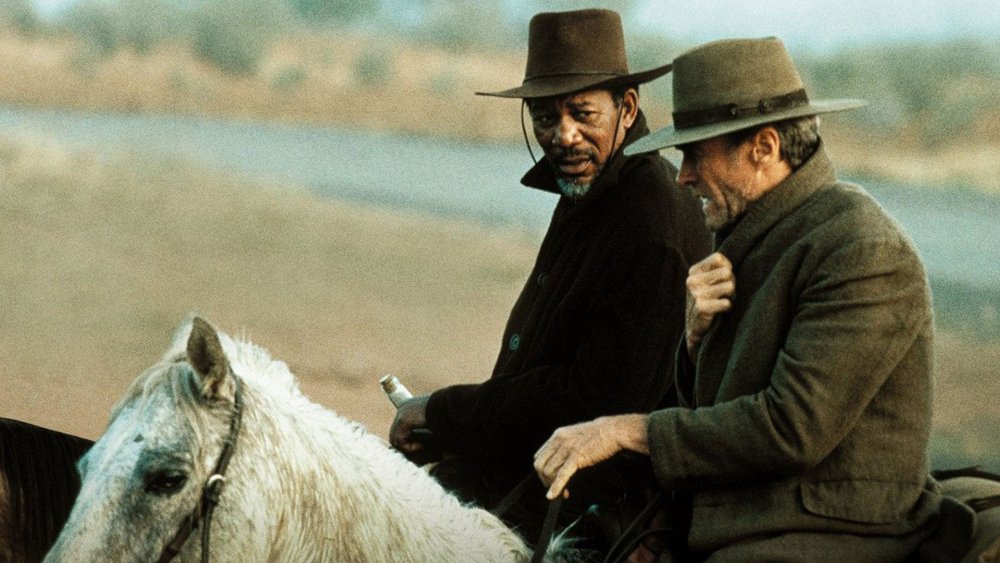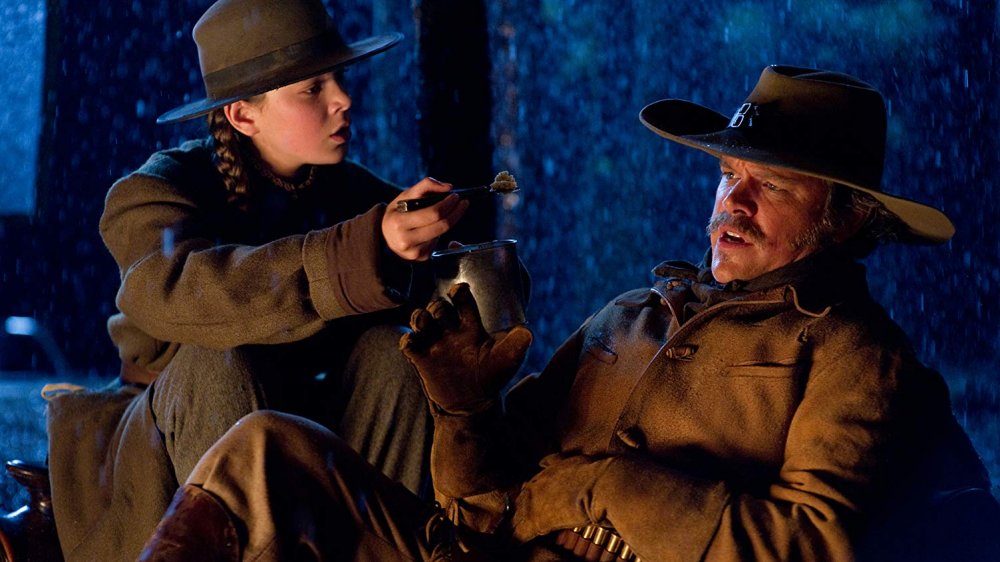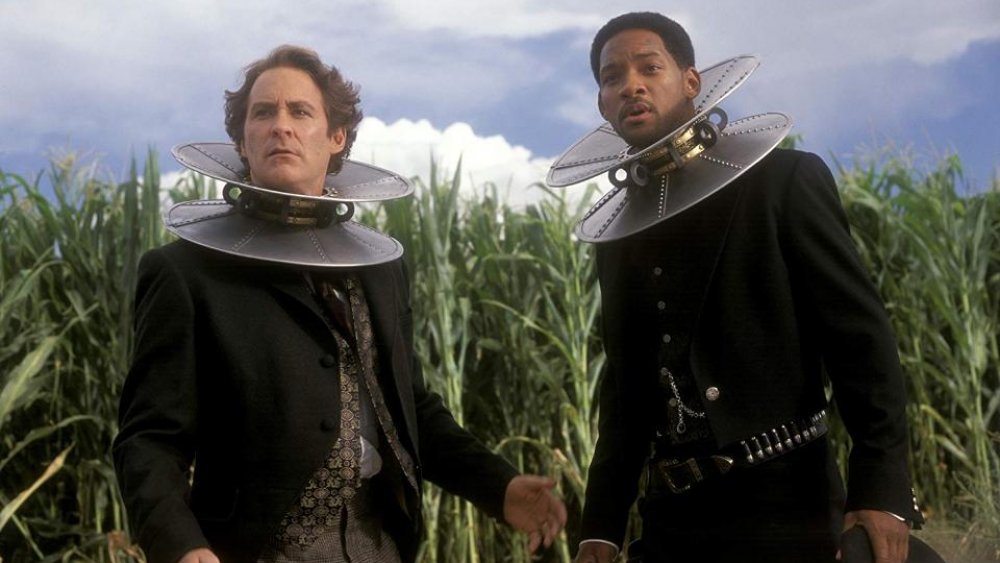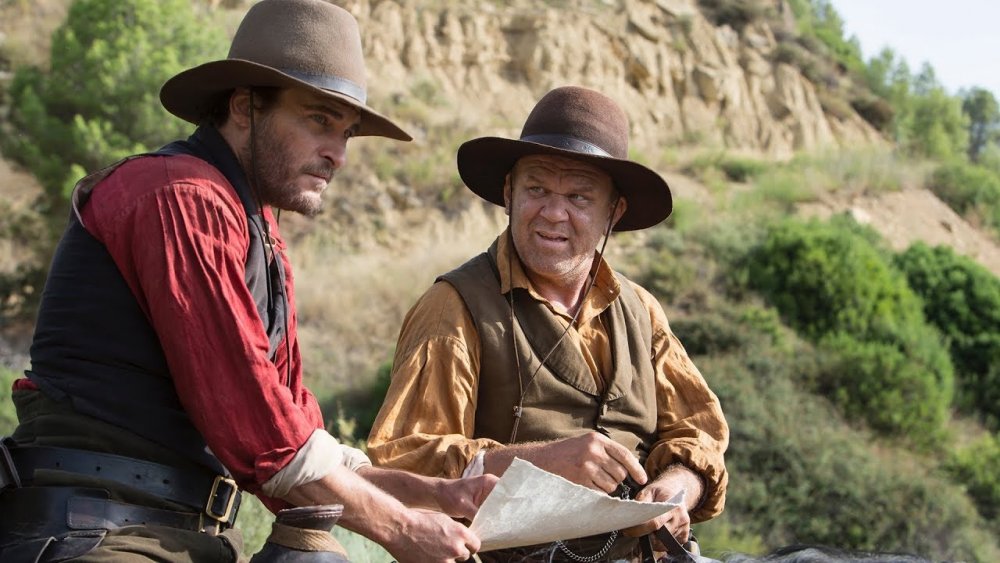The Real Reason They Don't Make Westerns Anymore
One of the benefits of film storytelling is its ability to transport the viewers to times and places completely different from their everyday experience. From the opening to closing credits, we can pretend to be in different galaxies, in foreign lands we may have never seen, or in eras past or future that we have no hope of ever experiencing in the real world. That explains, in part, the allure of Westerns, which give us the opportunity to journey back over a century before concrete and asphalt tamed the wilderness.
There was a time when you could hardly throw a rock in Hollywood without it hitting the saloon doors of a Western film production. When films were still silent, Westerns proved one of the most popular genres. Their popularity dipped soon after sound was introduced to motion pictures, but starting in the late 1930s, their star rose again, and they remained one of the most popular movie genres throughout the '50s.
But in more recent years, the Western has started to disappear as much as the once wild frontier it portrays. In spite of studios throwing gobs of money at science fiction and fantasy films which likewise transport audiences to different times and places, stories of showdowns at high noon and masked horsemen robbing steam locomotives hardly ever find their way into theaters. Let's take a look at the real reasons why studios aren't making Westerns anymore.
There have been too many flops
The early 2010s saw a few attempts by Hollywood to strike gold with big-budget Westerns, and in most cases, the studios found nothing in spite of impressive star power.
The first of what became something of an unholy trinity of Western killers was 2010's Jonah Hex, starring Josh Brolin as the titular antihero gunslinger. Based on the popular DC Comics character who usually pops up in time travel stories with superheroes like Batman and Superman, Jonah Hex was a massive bomb. In spite of Brolin being joined by popular actors like Michael Fassbender and Megan Fox, Jonah Hex's lazy storytelling was rewarded with only a quarter of the $47 million it took to make the movie. Next came 2011's Cowboys & Aliens which — in spite of director Jon Favreau coming off the game-changing Iron Man and boasting stars Harrison Ford and Daniel Craig — flopped stateside and barely broke even once it went overseas.
But the crowning jewel on these Western disappointments was 2013's The Lone Ranger. One of the most expensive flops ever made, the film starred Armie Hammer as the masked hero and Johnny Depp as his comrade Tonto. With the same director (Gore Verbinski) responsible for the first three Pirates of the Caribbean films and Depp starring as a heavily costumed eccentric, The Lone Ranger was critically panned as an unimaginative Pirates clone. Like Cowboys & Aliens, The Lone Ranger needed to go overseas to squeeze out a profit.
They're pretty expensive
You can make a low-budget Western, but if you're looking for the kind of movie that's going to compete with other big action features, you can't do it on the cheap.
It can seem counterintuitive when you think of a Western, with the characters' usually disheveled, soiled clothing and the one-street towns that look like no one in the place could've made more than $50 that year. But any period piece — whether it's set in ancient Rome, medieval Europe, or the Old West — is going to include a heavy price tag because the filmmakers need to build a world from scratch. Every piece of clothing, every building, every tool, and every weapon must reflect another time and place. Every horse has to be paid for, and they don't sell 19th-century steam locomotives at Costco.
A perfect example of this is the 2007 remake of 3:10 to Yuma starring Russell Crowe and Christian Bale. A new town was built from scratch for the film, but the production ran out of money, and so the fact that the town was unfinished for lack of funds was written into the story. And, by the way, in spite of both popular stars like Crowe and Bale and largely favorable reviews, the 2007 remake barely turned a profit.
Westerns don't do as well overseas
For some time, it's been predicted that China would eventually surpass the U.S. and Canada to become the biggest market in the world for movie ticket sales. For example, while it was hardly the first prediction of its type, in June 2019, The Hollywood Reporter claimed that China would officially become the biggest movie market by 2020.
That isn't good news for Westerns. In the wake of the failure of 2013's The Lone Ranger, Michael Agresta of The Atlantic took a long look at why Westerns were declining. Among the many factors Agresta covers, he mentions "the rejection of cowboy movies by international audiences, particularly the Chinese." Considering how important China is becoming to anyone making movies, anything unpopular in China is going to have that much of a harder road being produced in the U.S. or anywhere else.
Agresta doesn't specifically address why Chinese audiences avoid Westerns, but it seems likely that a big reason is that the Western is a largely American genre. While there have been plenty of apt parallels drawn between Japanese samurai films and cowboy flicks, the very notion of hardened adventurers contending with the frontier is something particularly made for America. It may be that for Westerns to survive and thrive, they'll have to find a way to appeal to a more global audience.
We live in a different world
In his look at the decline of the Western for The Atlantic, Michael Agresta argues that "through the past century of Western movies, we can trace America's self-image." For example, he writes that in Westerns produced during World War I and World War II, cowboys were — like we envisioned our soldiers — "heroes taking the good fight to savage enemies."
As America's politics grew more ambiguous in the decades that followed, Agresta argues that "the figure of the cowboy grew darker and more complicated." He raises movies like Butch Cassidy & the Sundance Kid and spaghetti Westerns as examples of films where the heroes weren't quite so pure as their predecessors. During the Vietnam War, Agresta points out, when many Americans were losing faith in their country's moral authority and were against the conflict, "cowboys were antiheroes as often as they were heroes."
We live in a much different world than what existed in the early, middle, or even late 20th century. If there's merit to Agresta's arguments, then a more polarized political environment may contribute to our lack of Westerns heroes, antiheroes, or anything in-between.
Making Westerns means facing ugly truths
Over the years, Hollywood has needed to grow increasingly conscious of political and social issues. In particular, filmmakers have to make sure that women, LGTBQ+ people, and people of color are being represented, and that those characters are more than just lazily reflections of old stereotypes. In this arena, Westerns are faced with a specifically unique challenge.
When it comes to Westerns set in the 19th century — as opposed to modern Westerns like No Country for Old Men — the stories of the time are intrinsically linked to the genocide of Native Americans. It's a heavy subject and one that lighter popcorn fare like Cowboys & Aliens and 2013's The Lone Ranger have a difficult time traversing. But to not face it, to ignore it in favor of "keeping it light," can offend and alienate as much as older Westerns that treated Native Americans as little more than one-dimensional villains to be blown away by righteous white heroes.
Some of the controversies that have risen in Westerns of recent years show the truth of this. When it came to The Lone Ranger, audiences were hotly divided on whether or not Johnny Depp's portrayal of Tonto was racist — something that probably didn't help ticket sales. A couple of years later, Netflix's The Ridiculous 6 endured negative press when Native American extras and the film's cultural adviser quit, claiming the filmmakers ignored their complaints over jokes they found to be racist and offensive.
Westerns are slower than other action films
At LRM Online, Nick Doll makes a convincing argument that Westerns suffer with modern audiences because of slower pacing. Westerns, Doll writes, are "intentionally and deliberately slow." He uses the example of one of the few successful big-budget Westerns of recent memory, 2016's remake of The Magnificent Seven. "Huge finale," Doll writes about the movie, "but not a lot before that. Slowly finding allies while riding for days, waiting for the bad guys to arrive so they can save the town ... then more waiting."
Doll has a point. Think of Western films, and you'll inevitably conjure memories of the heroes swapping stories over campfires and traveling across gorgeous landscapes on horseback. Westerns are slow, and fans of the genre like that about them. But when you compare it to something like an Avengers movie where heroes are blasting through space and time and battling armies of robots every other scene or a Fast & Furious flick where they're dropping cars out of planes into water or something equally improbable, then the merit of Doll's argument becomes clear.
Take a movie like the Oscar-winning Unforgiven. A practically flawless movie, it's still a beloved Western decades later, but it's over two hours long, and there isn't a bona fide shoot-out until the final moments of the film. If you're a fan, then you don't mind and probably even savor the slow build-up. But if you're more conditioned by faster-paced action fare, you may not have the patience.
They don't have enough spectacle
The advent of CGI has made so much possible. In particular, fantasy, science fiction, and superhero adaptations have benefited from digital contributions to moviemaking. Without it, most if not all of the big-budget event films of the past few decades wouldn't have happened — at least, not in a live-action format. Green screens, motion capture technology, and other digital moviemaking innovations make a kind of spectacle possible in other big-budget action films that Westerns simply can't compete with.
Consider the Siege of Gondor in The Return of the King and remember the heroic Rohirrim charging the Mumakil — the massive, horned elephant-like creatures. Remember watching Thor and the Hulk bat aliens off a space beast gliding through Manhattan in The Avengers or the unbelievable final battle of Avengers: Endgame, featuring villains and heroes from over a half dozen different franchises. Think of the wizard wars in Harry Potter, the explosives and high-speed chases of a Fast & Furious film, or the clashes of space fleets in Star Wars.
A Western? If it's a straight Western and not mixed with another genre like Cowboys & Aliens, then at best, it will have a bunch of people shooting at each other. Listen, we're not dissing Westerns. It's just that they're usually set in a time where the potential for stunning visual spectacle can't compete with armies of giant war elephants or a 50-foot-tall Paul Rudd breaking a flying space whale's jaw.
Westerns don't mix well with other genres
If we accept the idea that Westerns are more limited than other genres when it comes to big-budget action fare, one possible solution is to mash it up with other genres. Unfortunately, that's an idea some filmmakers have already had, and so far, it hasn't worked out well.
One of the most recent examples is 2011's Cowboys & Aliens, which was a disappointment critically and financially. Another example is 1999's Wild Wild West, which fused the Western with steampunk technology. In the film, Kevin Kline's Artemus Gordon boasted an arsenal of unique gadgets, and the villain, Dr. Arliss Loveless (Kenneth Brannagh), was a cybernetic, steam-powered spider from the waist down. But in spite of Will Smith in a starring role and director Barry Sonnenfeld coming off the huge hit Men in Black, Wild Wild West was a tremendous flop and ended Smith's hot streak.
One of the few exceptions to the rule is 1990's Back to the Future Part III, but that was the third in a series of already popular films that had nothing to do with the frontier until its final installment.
Westerns force studios to choose between awards and money
In many cases, these days, Westerns are becoming the purview of indie filmmakers. With Westerns largely underperforming against other big-budget flicks, sometimes the low-budget films are all that's left. It puts studios in the position of winning critical acclaim or making a profit, and for many studios, the choice between those two is clear.
Take, for example, 2007's The Assassination of Jesse James by the Coward Robert Ford. While it received largely positive reviews and starred Brad Pitt and Casey Affleck, it struggled to make even half of its $30 million budget. More recently, there was 2018's The Sisters Brothers starring Joaquin Phoenix, John C. Reilly, and Jake Gyllenhaal. The unique, acclaimed Western about a pair of unlikely guns for hire made a mere $13 million worldwide (and only $3 million domestic). And even the Westerns that make good money don't make as much money. Talking about the decline of Westerns, LRM Online's Nick Doll points out that while The Magnificent Seven did well at the box office, it was Chris Pratt's lowest-grossing film since becoming a star in Guardians of the Galaxy.
It may be that the future of the Western is in the art house. Though if it means better movies, Western fans might not mind.
